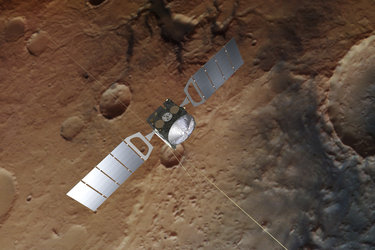Relays from Mars demonstrate international interplanetary networking
ESA PR 47-2004. ESA’s Mars Express has relayed pictures from one of NASA's Mars rovers for the first time, as part of a set of interplanetary networking demonstrations.
The demonstrations pave the way for future Mars missions to draw on joint interplanetary networking capabilities. ESA and NASA planned these demonstrations as part of continuing efforts to co-operate in space exploration.
On 4 August at 14:24 CEST, as Mars Express flew over one of NASA’s Mars exploration rovers, Opportunity, it successfully received data previously collected and stored by the rover. The data, including 15 science images from the rover's nine cameras, were then downlinked to ESA’s European Space Operations Centre in Darmstadt (Germany) and immediately relayed to the Mars Exploration Rovers team based at the Jet Propulsion Laboratory in Pasadena, USA.
NASA orbiters Mars Odyssey and Mars Global Surveyor have so far relayed most of the data produced by the rovers since they landed in January. Communication compatibility between Mars Express and the rovers had already been demonstrated in February, although at a low rate that did not convey much data. The 4 August session, at a transmit rate of 42.6 megabits in about six minutes, set a new mark for international networking around another planet.

The success of this demonstration is the result of years of groundwork and was made possible because both Mars Express and the Mars rovers use the same communication protocol. This protocol, called Proximity-1, was developed by the international Consultative Committee for Space Data Systems, an international partnership for standardising techniques for handling space data.
Mars Express was 1400 kilometres above the Martian surface during the 4 August session with Opportunity, with the goal of a reliable transfer of lots of data. Engineers for both agencies plan to repeat this display of international cooperation today, 10 August, with another set of Opportunity images.
“We're delighted how well this has been working, and thankful to have Mars Express in orbit,” said Richard Horttor of NASA's Jet Propulsion Laboratory, Pasadena, California, project manager for NASA's role in Mars Express. JPL engineer Gary Noreen of the Mars Network Office said: “the capabilities that our international teamwork is advancing this month could be important in future exploration of Mars.”
In addition, Mars Express is verifying two other operating modes with Opportunity and the twin rover, Spirit, from a greater distance. On 3 and 6 August, when Mars Express listened to Spirit, it was about 6000 kilometres above the surface. At this range it successfully tracked a beacon from Spirit, demonstrating a capability that can be used to locate another craft during critical events, such as the descent to a planet’s surface, or for orbital rendez-vous manoeuvres.
“Establishing a reliable communication network around Mars or other planets is crucial for future exploration missions, as it will allow improved coverage and also an increase in the amount of data that can be brought back to Earth,” said Con McCarthy, from ESA’s Mars Express project, “the tracking mode will enable ESA and NASA to pinpoint a spacecraft’s position more accurately during critical mission phases.”
The final session of the series, scheduled for 13 August with Opportunity, will demonstrate a mode for gaining navigational information from the ‘Doppler shift’ in the radio signal.
For more information, please contact:
Franco Bonacina
ESA Media Relations Division
Paris, France
Tel: +33 1 5369 7155
Fax: +33 1 5369 7690
Donald Savage
NASA Headquarters
Washington, USA
Tel: +1 202-358-1547
Guy Webster
Jet Propulsion Laboratory
Pasadena, USA
Tel: +1 818-354-5011





